Business and Business Environment: Unilever Report and Analysis
VerifiedAdded on 2021/01/01
|14
|3649
|95
Report
AI Summary
This report provides a comprehensive analysis of Unilever's business environment, examining both micro and macro factors that influence its operations. The introduction outlines the scope of the report, focusing on Unilever's diverse product portfolio and the importance of strategic analysis. Task 1 covers preliminary information, while Task 2 delves into the relationships between organizational functions within Unilever, such as production, research and development, finance, human resources, administration, and sales and marketing, highlighting their interdependencies. It also explores the positive and negative influences of the macro-environment using PESTEL analysis, detailing political, economic, social, technological, environmental, and legal factors. Task 3 presents an internal and external analysis of the company, utilizing SWOT analysis to identify Unilever's strengths, weaknesses, opportunities, and threats. The report concludes by linking these internal and external factors to provide a holistic view of Unilever's strategic position and future prospects.
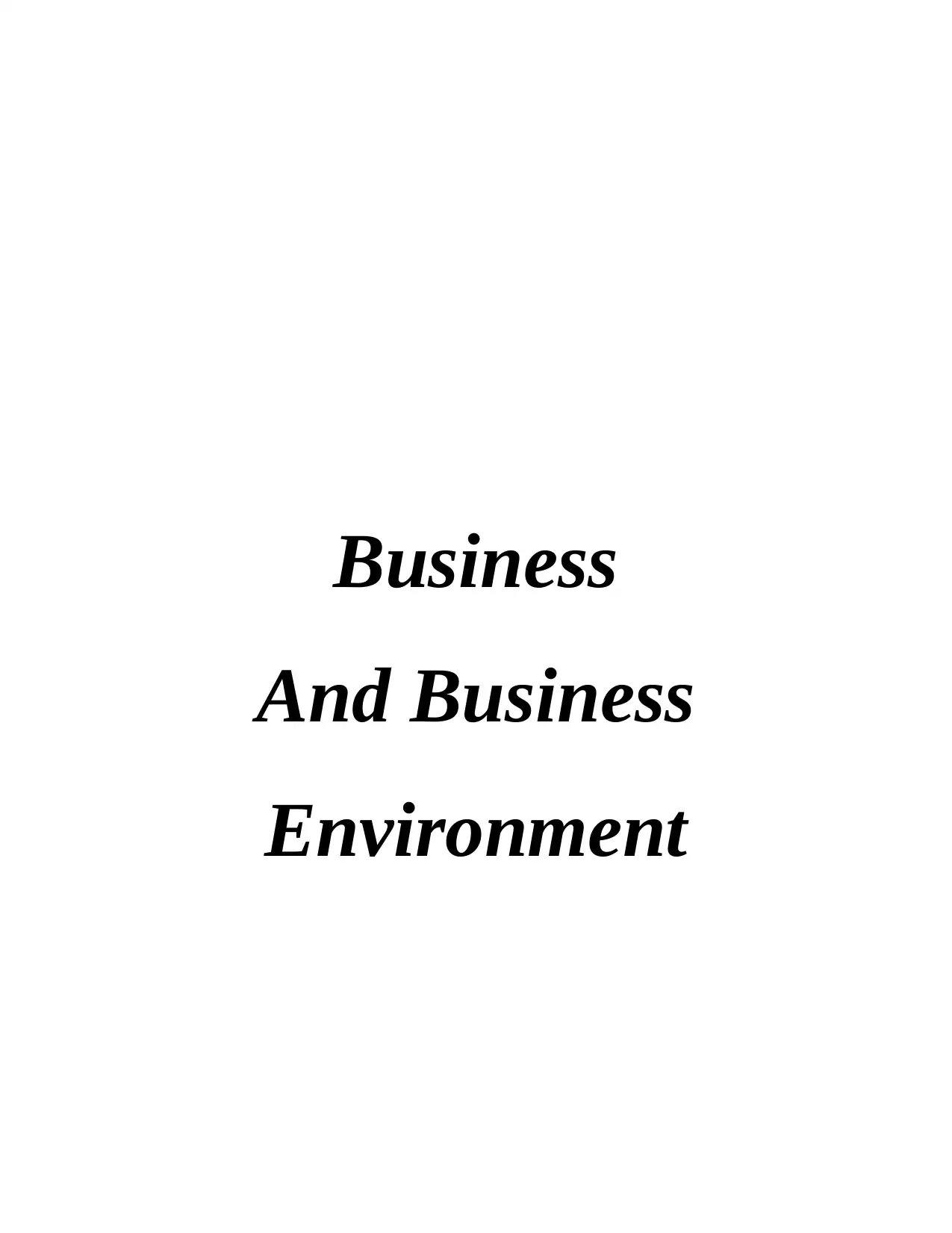
Business
And Business
Environment
And Business
Environment
Paraphrase This Document
Need a fresh take? Get an instant paraphrase of this document with our AI Paraphraser
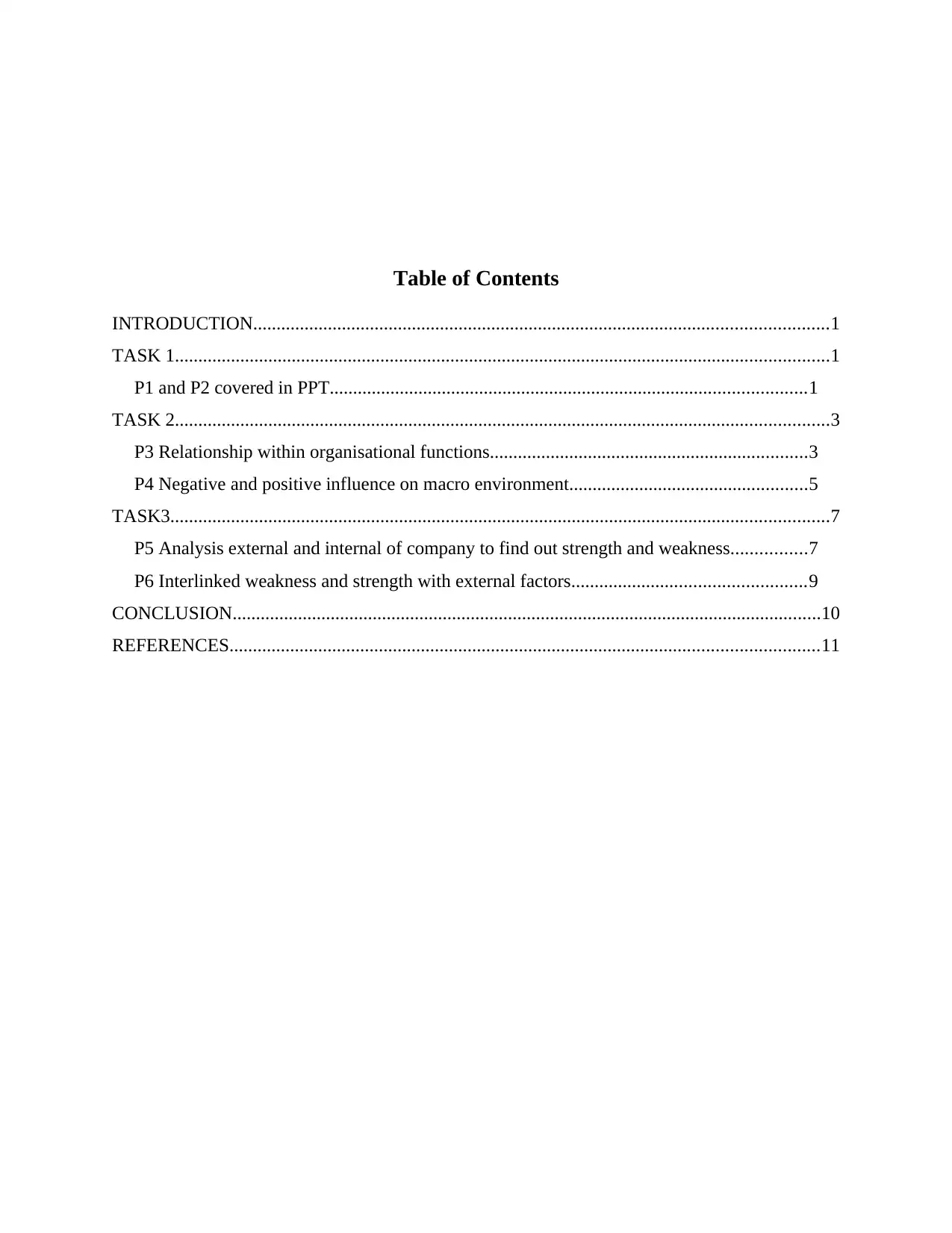
Table of Contents
INTRODUCTION...........................................................................................................................1
TASK 1............................................................................................................................................1
P1 and P2 covered in PPT......................................................................................................1
TASK 2............................................................................................................................................3
P3 Relationship within organisational functions....................................................................3
P4 Negative and positive influence on macro environment...................................................5
TASK3.............................................................................................................................................7
P5 Analysis external and internal of company to find out strength and weakness................7
P6 Interlinked weakness and strength with external factors..................................................9
CONCLUSION..............................................................................................................................10
REFERENCES..............................................................................................................................11
INTRODUCTION...........................................................................................................................1
TASK 1............................................................................................................................................1
P1 and P2 covered in PPT......................................................................................................1
TASK 2............................................................................................................................................3
P3 Relationship within organisational functions....................................................................3
P4 Negative and positive influence on macro environment...................................................5
TASK3.............................................................................................................................................7
P5 Analysis external and internal of company to find out strength and weakness................7
P6 Interlinked weakness and strength with external factors..................................................9
CONCLUSION..............................................................................................................................10
REFERENCES..............................................................................................................................11
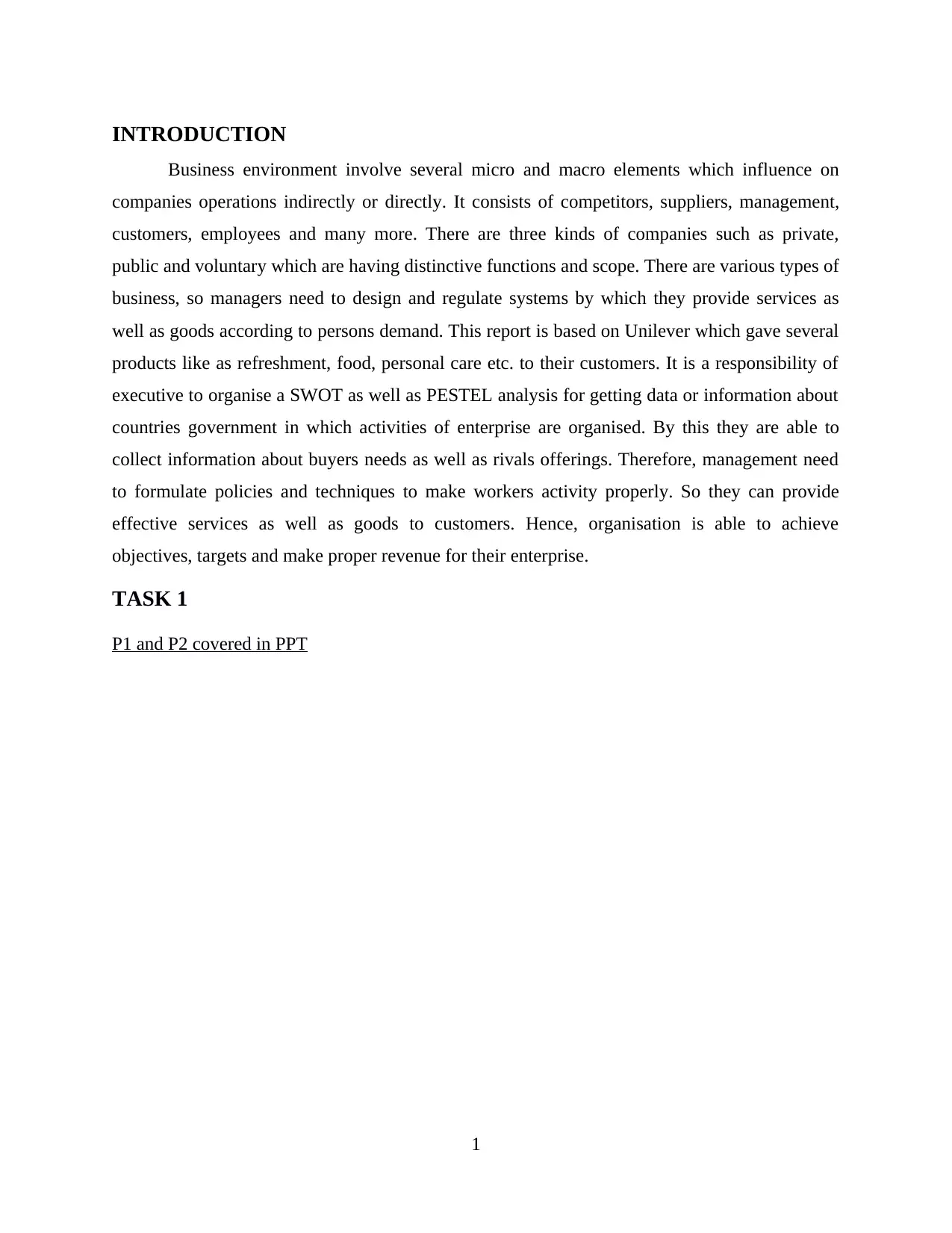
INTRODUCTION
Business environment involve several micro and macro elements which influence on
companies operations indirectly or directly. It consists of competitors, suppliers, management,
customers, employees and many more. There are three kinds of companies such as private,
public and voluntary which are having distinctive functions and scope. There are various types of
business, so managers need to design and regulate systems by which they provide services as
well as goods according to persons demand. This report is based on Unilever which gave several
products like as refreshment, food, personal care etc. to their customers. It is a responsibility of
executive to organise a SWOT as well as PESTEL analysis for getting data or information about
countries government in which activities of enterprise are organised. By this they are able to
collect information about buyers needs as well as rivals offerings. Therefore, management need
to formulate policies and techniques to make workers activity properly. So they can provide
effective services as well as goods to customers. Hence, organisation is able to achieve
objectives, targets and make proper revenue for their enterprise.
TASK 1
P1 and P2 covered in PPT
1
Business environment involve several micro and macro elements which influence on
companies operations indirectly or directly. It consists of competitors, suppliers, management,
customers, employees and many more. There are three kinds of companies such as private,
public and voluntary which are having distinctive functions and scope. There are various types of
business, so managers need to design and regulate systems by which they provide services as
well as goods according to persons demand. This report is based on Unilever which gave several
products like as refreshment, food, personal care etc. to their customers. It is a responsibility of
executive to organise a SWOT as well as PESTEL analysis for getting data or information about
countries government in which activities of enterprise are organised. By this they are able to
collect information about buyers needs as well as rivals offerings. Therefore, management need
to formulate policies and techniques to make workers activity properly. So they can provide
effective services as well as goods to customers. Hence, organisation is able to achieve
objectives, targets and make proper revenue for their enterprise.
TASK 1
P1 and P2 covered in PPT
1
⊘ This is a preview!⊘
Do you want full access?
Subscribe today to unlock all pages.

Trusted by 1+ million students worldwide
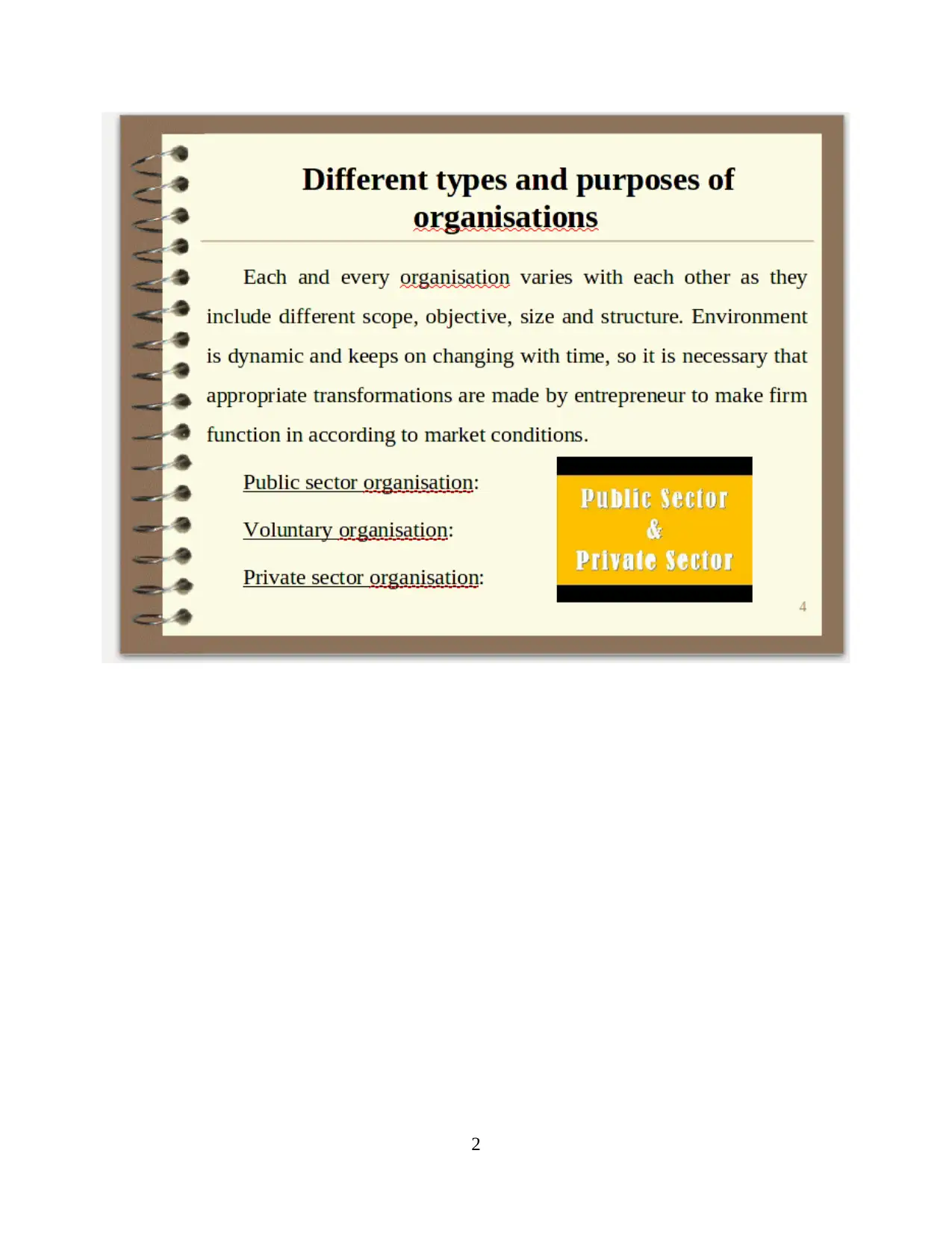
2
Paraphrase This Document
Need a fresh take? Get an instant paraphrase of this document with our AI Paraphraser
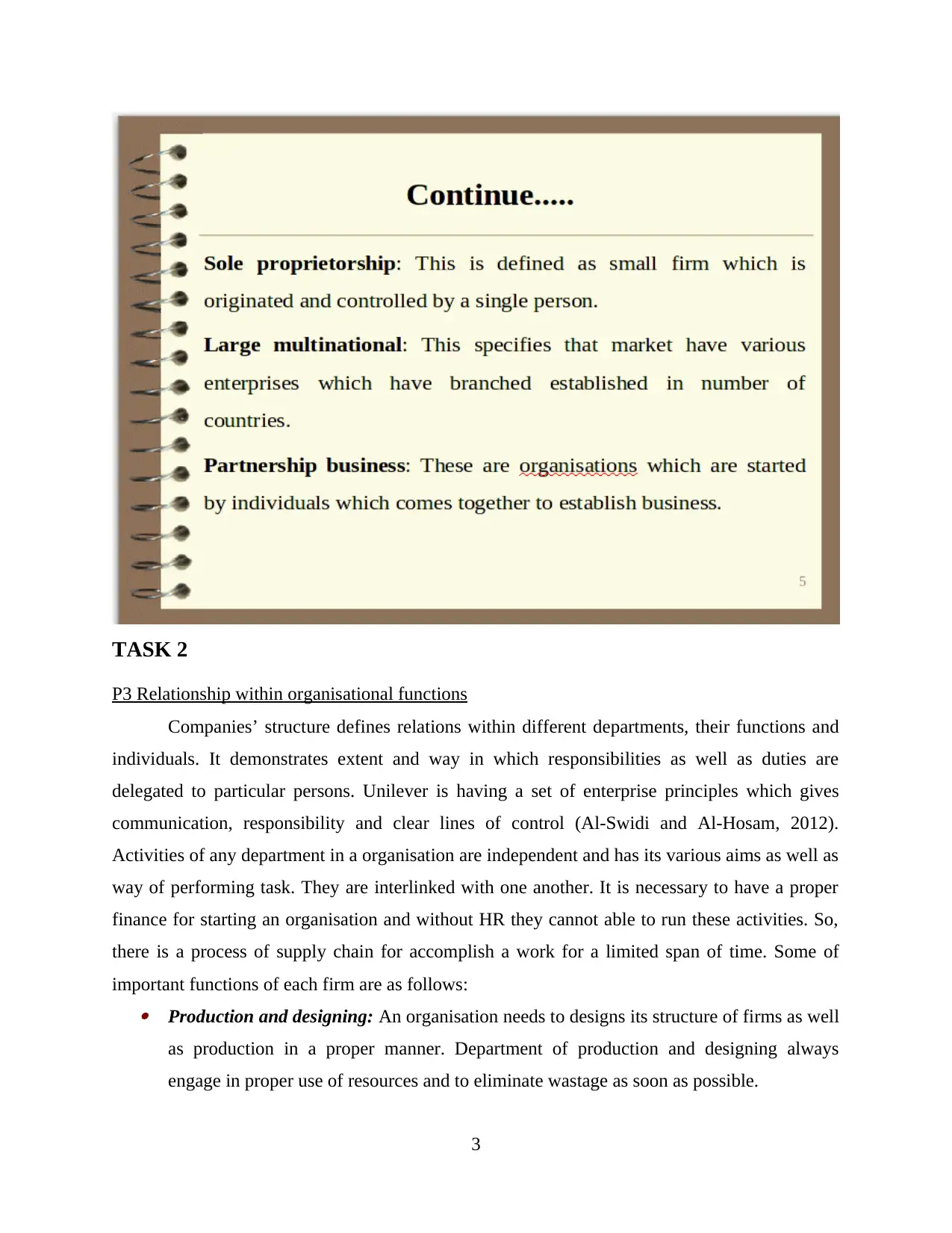
TASK 2
P3 Relationship within organisational functions
Companies’ structure defines relations within different departments, their functions and
individuals. It demonstrates extent and way in which responsibilities as well as duties are
delegated to particular persons. Unilever is having a set of enterprise principles which gives
communication, responsibility and clear lines of control (Al-Swidi and Al-Hosam, 2012).
Activities of any department in a organisation are independent and has its various aims as well as
way of performing task. They are interlinked with one another. It is necessary to have a proper
finance for starting an organisation and without HR they cannot able to run these activities. So,
there is a process of supply chain for accomplish a work for a limited span of time. Some of
important functions of each firm are as follows: Production and designing: An organisation needs to designs its structure of firms as well
as production in a proper manner. Department of production and designing always
engage in proper use of resources and to eliminate wastage as soon as possible.
3
P3 Relationship within organisational functions
Companies’ structure defines relations within different departments, their functions and
individuals. It demonstrates extent and way in which responsibilities as well as duties are
delegated to particular persons. Unilever is having a set of enterprise principles which gives
communication, responsibility and clear lines of control (Al-Swidi and Al-Hosam, 2012).
Activities of any department in a organisation are independent and has its various aims as well as
way of performing task. They are interlinked with one another. It is necessary to have a proper
finance for starting an organisation and without HR they cannot able to run these activities. So,
there is a process of supply chain for accomplish a work for a limited span of time. Some of
important functions of each firm are as follows: Production and designing: An organisation needs to designs its structure of firms as well
as production in a proper manner. Department of production and designing always
engage in proper use of resources and to eliminate wastage as soon as possible.
3
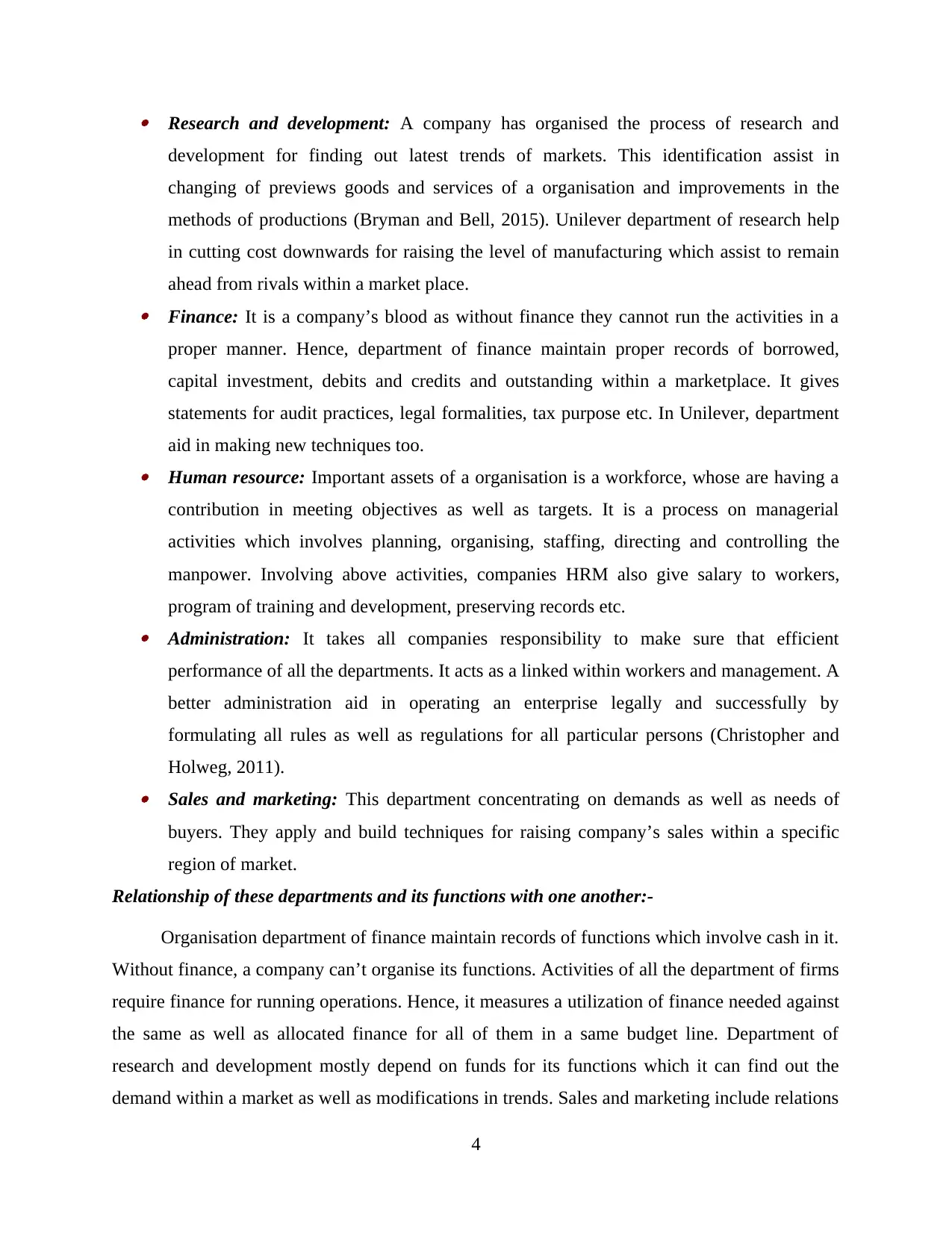
Research and development: A company has organised the process of research and
development for finding out latest trends of markets. This identification assist in
changing of previews goods and services of a organisation and improvements in the
methods of productions (Bryman and Bell, 2015). Unilever department of research help
in cutting cost downwards for raising the level of manufacturing which assist to remain
ahead from rivals within a market place. Finance: It is a company’s blood as without finance they cannot run the activities in a
proper manner. Hence, department of finance maintain proper records of borrowed,
capital investment, debits and credits and outstanding within a marketplace. It gives
statements for audit practices, legal formalities, tax purpose etc. In Unilever, department
aid in making new techniques too. Human resource: Important assets of a organisation is a workforce, whose are having a
contribution in meeting objectives as well as targets. It is a process on managerial
activities which involves planning, organising, staffing, directing and controlling the
manpower. Involving above activities, companies HRM also give salary to workers,
program of training and development, preserving records etc. Administration: It takes all companies responsibility to make sure that efficient
performance of all the departments. It acts as a linked within workers and management. A
better administration aid in operating an enterprise legally and successfully by
formulating all rules as well as regulations for all particular persons (Christopher and
Holweg, 2011). Sales and marketing: This department concentrating on demands as well as needs of
buyers. They apply and build techniques for raising company’s sales within a specific
region of market.
Relationship of these departments and its functions with one another:-
Organisation department of finance maintain records of functions which involve cash in it.
Without finance, a company can’t organise its functions. Activities of all the department of firms
require finance for running operations. Hence, it measures a utilization of finance needed against
the same as well as allocated finance for all of them in a same budget line. Department of
research and development mostly depend on funds for its functions which it can find out the
demand within a market as well as modifications in trends. Sales and marketing include relations
4
development for finding out latest trends of markets. This identification assist in
changing of previews goods and services of a organisation and improvements in the
methods of productions (Bryman and Bell, 2015). Unilever department of research help
in cutting cost downwards for raising the level of manufacturing which assist to remain
ahead from rivals within a market place. Finance: It is a company’s blood as without finance they cannot run the activities in a
proper manner. Hence, department of finance maintain proper records of borrowed,
capital investment, debits and credits and outstanding within a marketplace. It gives
statements for audit practices, legal formalities, tax purpose etc. In Unilever, department
aid in making new techniques too. Human resource: Important assets of a organisation is a workforce, whose are having a
contribution in meeting objectives as well as targets. It is a process on managerial
activities which involves planning, organising, staffing, directing and controlling the
manpower. Involving above activities, companies HRM also give salary to workers,
program of training and development, preserving records etc. Administration: It takes all companies responsibility to make sure that efficient
performance of all the departments. It acts as a linked within workers and management. A
better administration aid in operating an enterprise legally and successfully by
formulating all rules as well as regulations for all particular persons (Christopher and
Holweg, 2011). Sales and marketing: This department concentrating on demands as well as needs of
buyers. They apply and build techniques for raising company’s sales within a specific
region of market.
Relationship of these departments and its functions with one another:-
Organisation department of finance maintain records of functions which involve cash in it.
Without finance, a company can’t organise its functions. Activities of all the department of firms
require finance for running operations. Hence, it measures a utilization of finance needed against
the same as well as allocated finance for all of them in a same budget line. Department of
research and development mostly depend on funds for its functions which it can find out the
demand within a market as well as modifications in trends. Sales and marketing include relations
4
⊘ This is a preview!⊘
Do you want full access?
Subscribe today to unlock all pages.

Trusted by 1+ million students worldwide
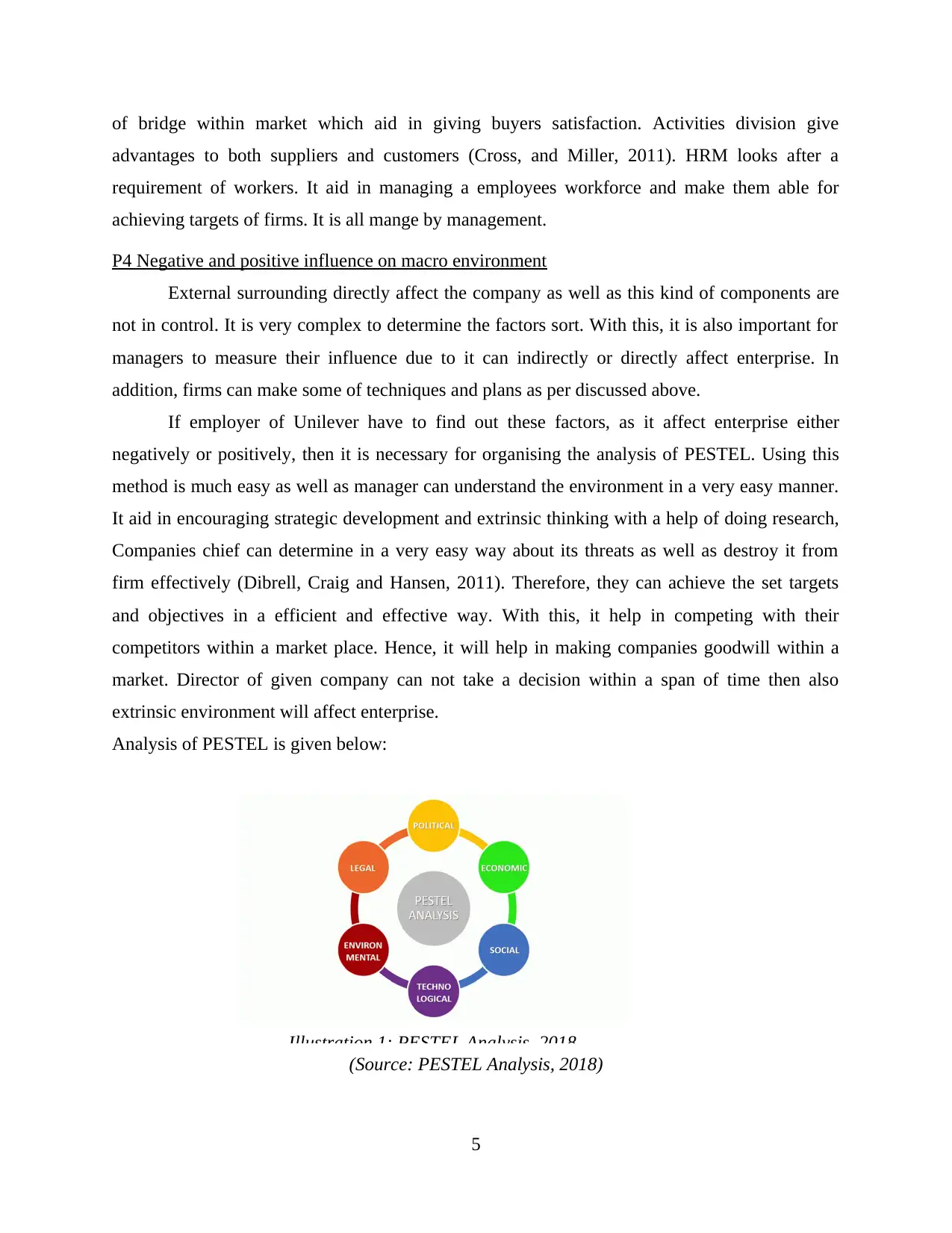
of bridge within market which aid in giving buyers satisfaction. Activities division give
advantages to both suppliers and customers (Cross, and Miller, 2011). HRM looks after a
requirement of workers. It aid in managing a employees workforce and make them able for
achieving targets of firms. It is all mange by management.
P4 Negative and positive influence on macro environment
External surrounding directly affect the company as well as this kind of components are
not in control. It is very complex to determine the factors sort. With this, it is also important for
managers to measure their influence due to it can indirectly or directly affect enterprise. In
addition, firms can make some of techniques and plans as per discussed above.
If employer of Unilever have to find out these factors, as it affect enterprise either
negatively or positively, then it is necessary for organising the analysis of PESTEL. Using this
method is much easy as well as manager can understand the environment in a very easy manner.
It aid in encouraging strategic development and extrinsic thinking with a help of doing research,
Companies chief can determine in a very easy way about its threats as well as destroy it from
firm effectively (Dibrell, Craig and Hansen, 2011). Therefore, they can achieve the set targets
and objectives in a efficient and effective way. With this, it help in competing with their
competitors within a market place. Hence, it will help in making companies goodwill within a
market. Director of given company can not take a decision within a span of time then also
extrinsic environment will affect enterprise.
Analysis of PESTEL is given below:
(Source: PESTEL Analysis, 2018)
5
Illustration 1: PESTEL Analysis, 2018
advantages to both suppliers and customers (Cross, and Miller, 2011). HRM looks after a
requirement of workers. It aid in managing a employees workforce and make them able for
achieving targets of firms. It is all mange by management.
P4 Negative and positive influence on macro environment
External surrounding directly affect the company as well as this kind of components are
not in control. It is very complex to determine the factors sort. With this, it is also important for
managers to measure their influence due to it can indirectly or directly affect enterprise. In
addition, firms can make some of techniques and plans as per discussed above.
If employer of Unilever have to find out these factors, as it affect enterprise either
negatively or positively, then it is necessary for organising the analysis of PESTEL. Using this
method is much easy as well as manager can understand the environment in a very easy manner.
It aid in encouraging strategic development and extrinsic thinking with a help of doing research,
Companies chief can determine in a very easy way about its threats as well as destroy it from
firm effectively (Dibrell, Craig and Hansen, 2011). Therefore, they can achieve the set targets
and objectives in a efficient and effective way. With this, it help in competing with their
competitors within a market place. Hence, it will help in making companies goodwill within a
market. Director of given company can not take a decision within a span of time then also
extrinsic environment will affect enterprise.
Analysis of PESTEL is given below:
(Source: PESTEL Analysis, 2018)
5
Illustration 1: PESTEL Analysis, 2018
Paraphrase This Document
Need a fresh take? Get an instant paraphrase of this document with our AI Paraphraser
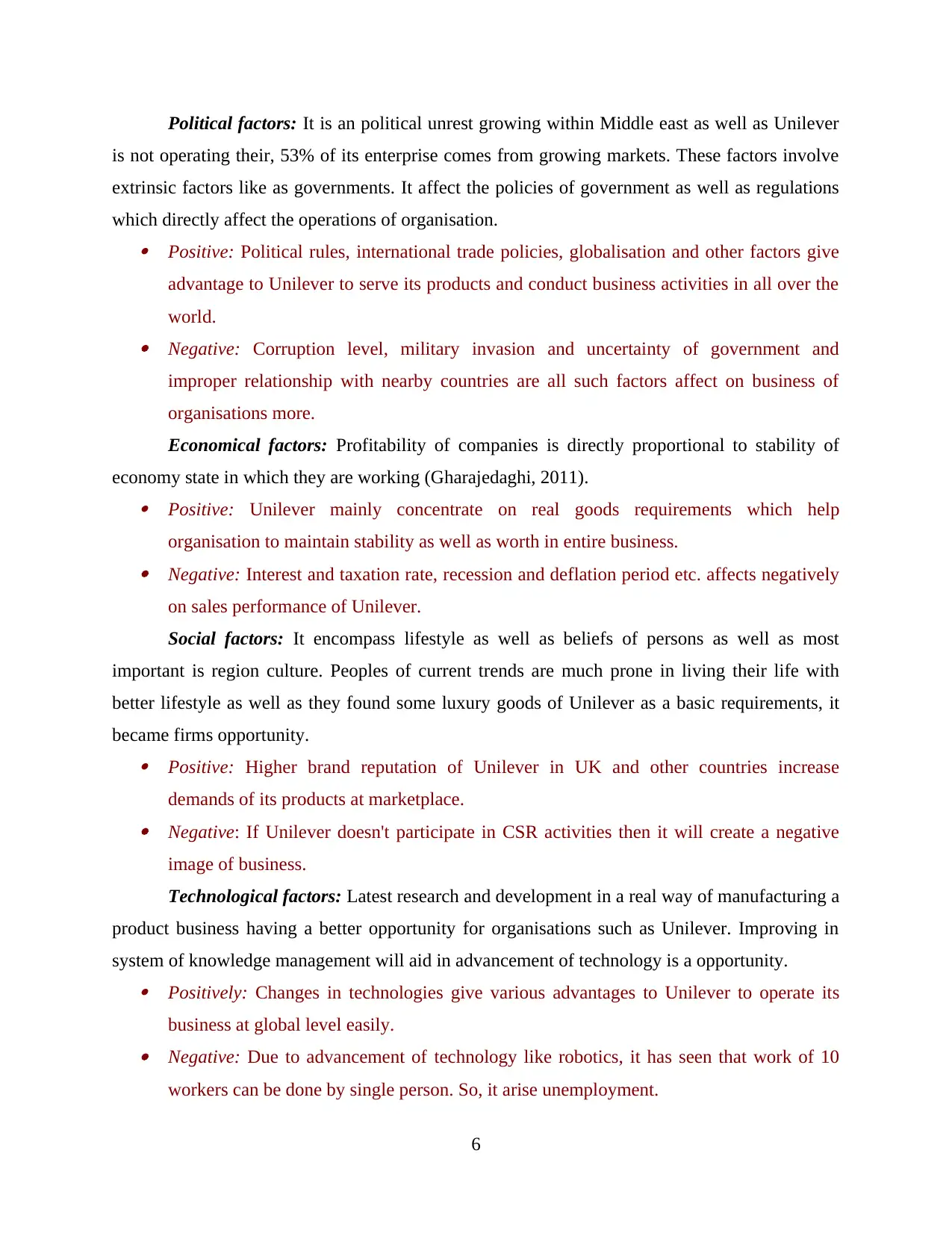
Political factors: It is an political unrest growing within Middle east as well as Unilever
is not operating their, 53% of its enterprise comes from growing markets. These factors involve
extrinsic factors like as governments. It affect the policies of government as well as regulations
which directly affect the operations of organisation. Positive: Political rules, international trade policies, globalisation and other factors give
advantage to Unilever to serve its products and conduct business activities in all over the
world. Negative: Corruption level, military invasion and uncertainty of government and
improper relationship with nearby countries are all such factors affect on business of
organisations more.
Economical factors: Profitability of companies is directly proportional to stability of
economy state in which they are working (Gharajedaghi, 2011). Positive: Unilever mainly concentrate on real goods requirements which help
organisation to maintain stability as well as worth in entire business. Negative: Interest and taxation rate, recession and deflation period etc. affects negatively
on sales performance of Unilever.
Social factors: It encompass lifestyle as well as beliefs of persons as well as most
important is region culture. Peoples of current trends are much prone in living their life with
better lifestyle as well as they found some luxury goods of Unilever as a basic requirements, it
became firms opportunity. Positive: Higher brand reputation of Unilever in UK and other countries increase
demands of its products at marketplace. Negative: If Unilever doesn't participate in CSR activities then it will create a negative
image of business.
Technological factors: Latest research and development in a real way of manufacturing a
product business having a better opportunity for organisations such as Unilever. Improving in
system of knowledge management will aid in advancement of technology is a opportunity. Positively: Changes in technologies give various advantages to Unilever to operate its
business at global level easily. Negative: Due to advancement of technology like robotics, it has seen that work of 10
workers can be done by single person. So, it arise unemployment.
6
is not operating their, 53% of its enterprise comes from growing markets. These factors involve
extrinsic factors like as governments. It affect the policies of government as well as regulations
which directly affect the operations of organisation. Positive: Political rules, international trade policies, globalisation and other factors give
advantage to Unilever to serve its products and conduct business activities in all over the
world. Negative: Corruption level, military invasion and uncertainty of government and
improper relationship with nearby countries are all such factors affect on business of
organisations more.
Economical factors: Profitability of companies is directly proportional to stability of
economy state in which they are working (Gharajedaghi, 2011). Positive: Unilever mainly concentrate on real goods requirements which help
organisation to maintain stability as well as worth in entire business. Negative: Interest and taxation rate, recession and deflation period etc. affects negatively
on sales performance of Unilever.
Social factors: It encompass lifestyle as well as beliefs of persons as well as most
important is region culture. Peoples of current trends are much prone in living their life with
better lifestyle as well as they found some luxury goods of Unilever as a basic requirements, it
became firms opportunity. Positive: Higher brand reputation of Unilever in UK and other countries increase
demands of its products at marketplace. Negative: If Unilever doesn't participate in CSR activities then it will create a negative
image of business.
Technological factors: Latest research and development in a real way of manufacturing a
product business having a better opportunity for organisations such as Unilever. Improving in
system of knowledge management will aid in advancement of technology is a opportunity. Positively: Changes in technologies give various advantages to Unilever to operate its
business at global level easily. Negative: Due to advancement of technology like robotics, it has seen that work of 10
workers can be done by single person. So, it arise unemployment.
6
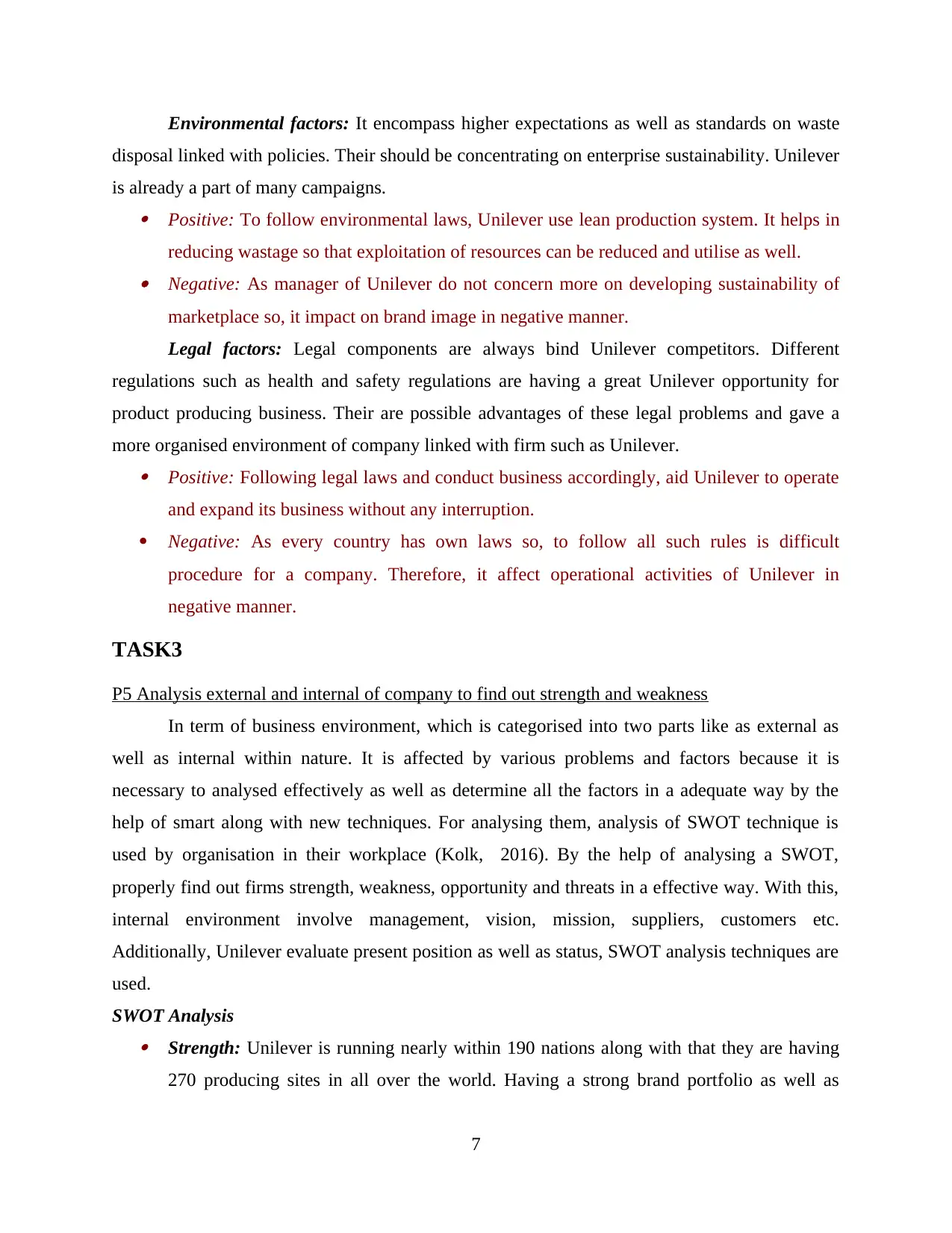
Environmental factors: It encompass higher expectations as well as standards on waste
disposal linked with policies. Their should be concentrating on enterprise sustainability. Unilever
is already a part of many campaigns. Positive: To follow environmental laws, Unilever use lean production system. It helps in
reducing wastage so that exploitation of resources can be reduced and utilise as well. Negative: As manager of Unilever do not concern more on developing sustainability of
marketplace so, it impact on brand image in negative manner.
Legal factors: Legal components are always bind Unilever competitors. Different
regulations such as health and safety regulations are having a great Unilever opportunity for
product producing business. Their are possible advantages of these legal problems and gave a
more organised environment of company linked with firm such as Unilever. Positive: Following legal laws and conduct business accordingly, aid Unilever to operate
and expand its business without any interruption.
Negative: As every country has own laws so, to follow all such rules is difficult
procedure for a company. Therefore, it affect operational activities of Unilever in
negative manner.
TASK3
P5 Analysis external and internal of company to find out strength and weakness
In term of business environment, which is categorised into two parts like as external as
well as internal within nature. It is affected by various problems and factors because it is
necessary to analysed effectively as well as determine all the factors in a adequate way by the
help of smart along with new techniques. For analysing them, analysis of SWOT technique is
used by organisation in their workplace (Kolk, 2016). By the help of analysing a SWOT,
properly find out firms strength, weakness, opportunity and threats in a effective way. With this,
internal environment involve management, vision, mission, suppliers, customers etc.
Additionally, Unilever evaluate present position as well as status, SWOT analysis techniques are
used.
SWOT Analysis Strength: Unilever is running nearly within 190 nations along with that they are having
270 producing sites in all over the world. Having a strong brand portfolio as well as
7
disposal linked with policies. Their should be concentrating on enterprise sustainability. Unilever
is already a part of many campaigns. Positive: To follow environmental laws, Unilever use lean production system. It helps in
reducing wastage so that exploitation of resources can be reduced and utilise as well. Negative: As manager of Unilever do not concern more on developing sustainability of
marketplace so, it impact on brand image in negative manner.
Legal factors: Legal components are always bind Unilever competitors. Different
regulations such as health and safety regulations are having a great Unilever opportunity for
product producing business. Their are possible advantages of these legal problems and gave a
more organised environment of company linked with firm such as Unilever. Positive: Following legal laws and conduct business accordingly, aid Unilever to operate
and expand its business without any interruption.
Negative: As every country has own laws so, to follow all such rules is difficult
procedure for a company. Therefore, it affect operational activities of Unilever in
negative manner.
TASK3
P5 Analysis external and internal of company to find out strength and weakness
In term of business environment, which is categorised into two parts like as external as
well as internal within nature. It is affected by various problems and factors because it is
necessary to analysed effectively as well as determine all the factors in a adequate way by the
help of smart along with new techniques. For analysing them, analysis of SWOT technique is
used by organisation in their workplace (Kolk, 2016). By the help of analysing a SWOT,
properly find out firms strength, weakness, opportunity and threats in a effective way. With this,
internal environment involve management, vision, mission, suppliers, customers etc.
Additionally, Unilever evaluate present position as well as status, SWOT analysis techniques are
used.
SWOT Analysis Strength: Unilever is running nearly within 190 nations along with that they are having
270 producing sites in all over the world. Having a strong brand portfolio as well as
7
⊘ This is a preview!⊘
Do you want full access?
Subscribe today to unlock all pages.

Trusted by 1+ million students worldwide
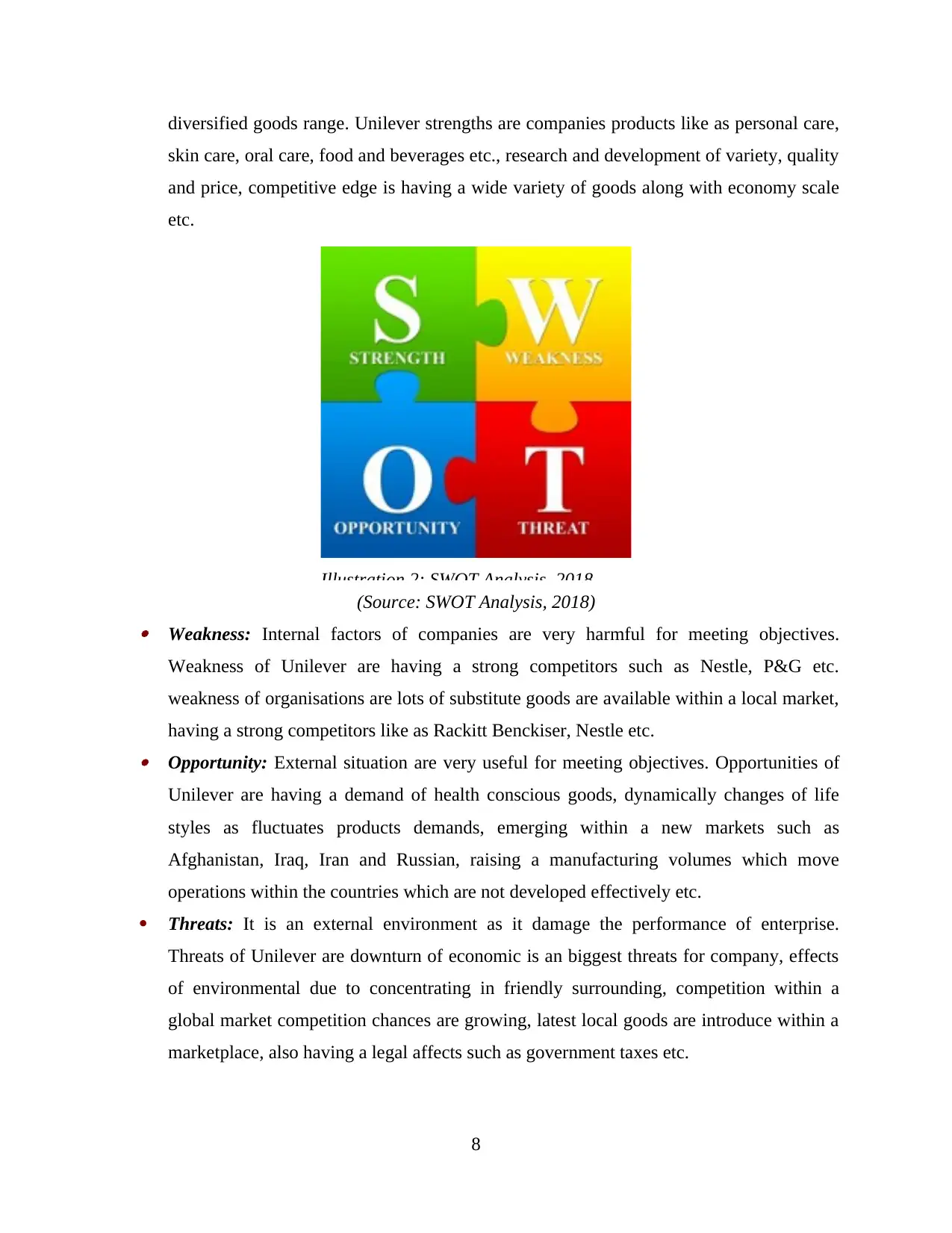
diversified goods range. Unilever strengths are companies products like as personal care,
skin care, oral care, food and beverages etc., research and development of variety, quality
and price, competitive edge is having a wide variety of goods along with economy scale
etc.
(Source: SWOT Analysis, 2018) Weakness: Internal factors of companies are very harmful for meeting objectives.
Weakness of Unilever are having a strong competitors such as Nestle, P&G etc.
weakness of organisations are lots of substitute goods are available within a local market,
having a strong competitors like as Rackitt Benckiser, Nestle etc. Opportunity: External situation are very useful for meeting objectives. Opportunities of
Unilever are having a demand of health conscious goods, dynamically changes of life
styles as fluctuates products demands, emerging within a new markets such as
Afghanistan, Iraq, Iran and Russian, raising a manufacturing volumes which move
operations within the countries which are not developed effectively etc.
Threats: It is an external environment as it damage the performance of enterprise.
Threats of Unilever are downturn of economic is an biggest threats for company, effects
of environmental due to concentrating in friendly surrounding, competition within a
global market competition chances are growing, latest local goods are introduce within a
marketplace, also having a legal affects such as government taxes etc.
8
Illustration 2: SWOT Analysis, 2018
skin care, oral care, food and beverages etc., research and development of variety, quality
and price, competitive edge is having a wide variety of goods along with economy scale
etc.
(Source: SWOT Analysis, 2018) Weakness: Internal factors of companies are very harmful for meeting objectives.
Weakness of Unilever are having a strong competitors such as Nestle, P&G etc.
weakness of organisations are lots of substitute goods are available within a local market,
having a strong competitors like as Rackitt Benckiser, Nestle etc. Opportunity: External situation are very useful for meeting objectives. Opportunities of
Unilever are having a demand of health conscious goods, dynamically changes of life
styles as fluctuates products demands, emerging within a new markets such as
Afghanistan, Iraq, Iran and Russian, raising a manufacturing volumes which move
operations within the countries which are not developed effectively etc.
Threats: It is an external environment as it damage the performance of enterprise.
Threats of Unilever are downturn of economic is an biggest threats for company, effects
of environmental due to concentrating in friendly surrounding, competition within a
global market competition chances are growing, latest local goods are introduce within a
marketplace, also having a legal affects such as government taxes etc.
8
Illustration 2: SWOT Analysis, 2018
Paraphrase This Document
Need a fresh take? Get an instant paraphrase of this document with our AI Paraphraser
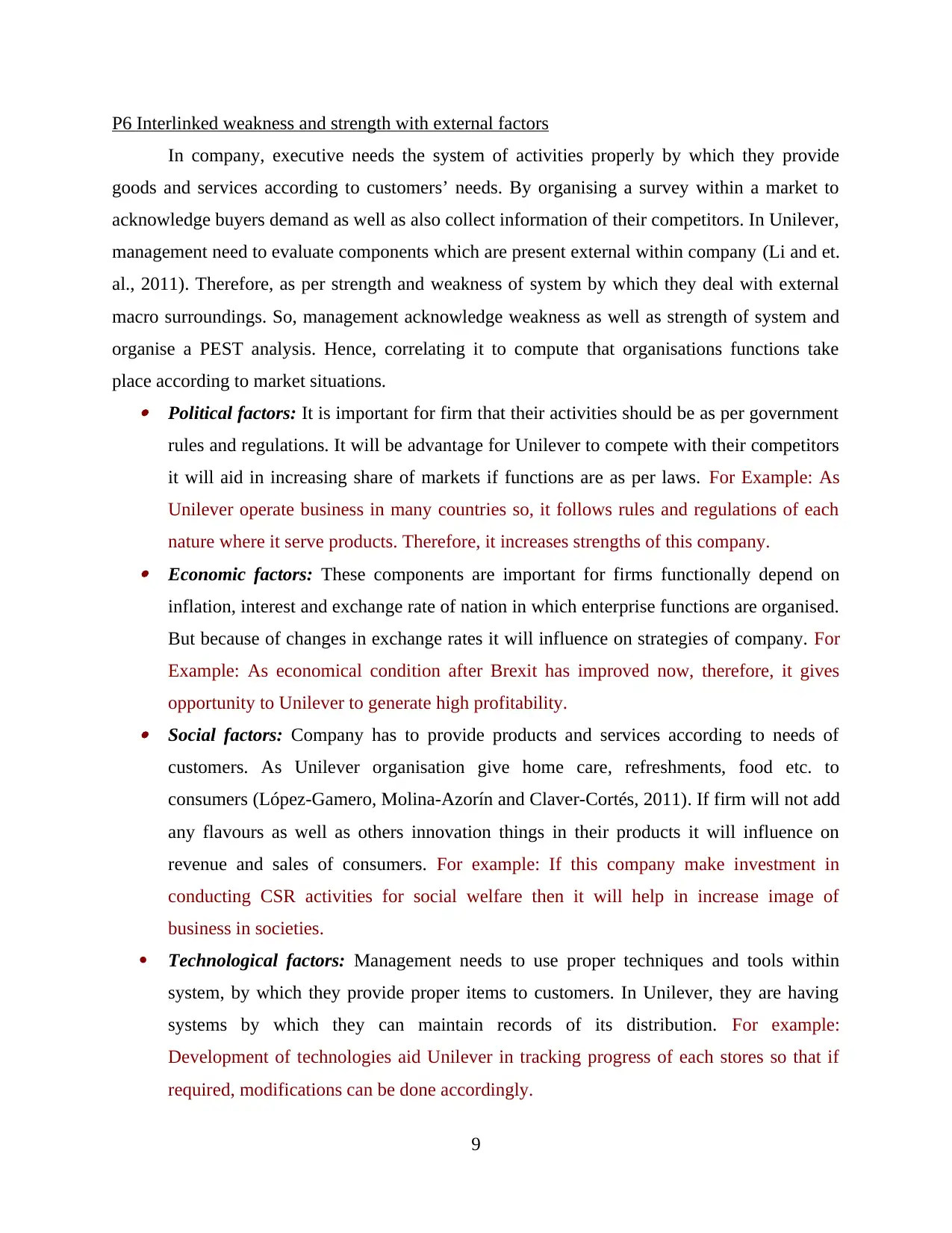
P6 Interlinked weakness and strength with external factors
In company, executive needs the system of activities properly by which they provide
goods and services according to customers’ needs. By organising a survey within a market to
acknowledge buyers demand as well as also collect information of their competitors. In Unilever,
management need to evaluate components which are present external within company (Li and et.
al., 2011). Therefore, as per strength and weakness of system by which they deal with external
macro surroundings. So, management acknowledge weakness as well as strength of system and
organise a PEST analysis. Hence, correlating it to compute that organisations functions take
place according to market situations. Political factors: It is important for firm that their activities should be as per government
rules and regulations. It will be advantage for Unilever to compete with their competitors
it will aid in increasing share of markets if functions are as per laws. For Example: As
Unilever operate business in many countries so, it follows rules and regulations of each
nature where it serve products. Therefore, it increases strengths of this company. Economic factors: These components are important for firms functionally depend on
inflation, interest and exchange rate of nation in which enterprise functions are organised.
But because of changes in exchange rates it will influence on strategies of company. For
Example: As economical condition after Brexit has improved now, therefore, it gives
opportunity to Unilever to generate high profitability. Social factors: Company has to provide products and services according to needs of
customers. As Unilever organisation give home care, refreshments, food etc. to
consumers (López-Gamero, Molina-Azorín and Claver-Cortés, 2011). If firm will not add
any flavours as well as others innovation things in their products it will influence on
revenue and sales of consumers. For example: If this company make investment in
conducting CSR activities for social welfare then it will help in increase image of
business in societies.
Technological factors: Management needs to use proper techniques and tools within
system, by which they provide proper items to customers. In Unilever, they are having
systems by which they can maintain records of its distribution. For example:
Development of technologies aid Unilever in tracking progress of each stores so that if
required, modifications can be done accordingly.
9
In company, executive needs the system of activities properly by which they provide
goods and services according to customers’ needs. By organising a survey within a market to
acknowledge buyers demand as well as also collect information of their competitors. In Unilever,
management need to evaluate components which are present external within company (Li and et.
al., 2011). Therefore, as per strength and weakness of system by which they deal with external
macro surroundings. So, management acknowledge weakness as well as strength of system and
organise a PEST analysis. Hence, correlating it to compute that organisations functions take
place according to market situations. Political factors: It is important for firm that their activities should be as per government
rules and regulations. It will be advantage for Unilever to compete with their competitors
it will aid in increasing share of markets if functions are as per laws. For Example: As
Unilever operate business in many countries so, it follows rules and regulations of each
nature where it serve products. Therefore, it increases strengths of this company. Economic factors: These components are important for firms functionally depend on
inflation, interest and exchange rate of nation in which enterprise functions are organised.
But because of changes in exchange rates it will influence on strategies of company. For
Example: As economical condition after Brexit has improved now, therefore, it gives
opportunity to Unilever to generate high profitability. Social factors: Company has to provide products and services according to needs of
customers. As Unilever organisation give home care, refreshments, food etc. to
consumers (López-Gamero, Molina-Azorín and Claver-Cortés, 2011). If firm will not add
any flavours as well as others innovation things in their products it will influence on
revenue and sales of consumers. For example: If this company make investment in
conducting CSR activities for social welfare then it will help in increase image of
business in societies.
Technological factors: Management needs to use proper techniques and tools within
system, by which they provide proper items to customers. In Unilever, they are having
systems by which they can maintain records of its distribution. For example:
Development of technologies aid Unilever in tracking progress of each stores so that if
required, modifications can be done accordingly.
9
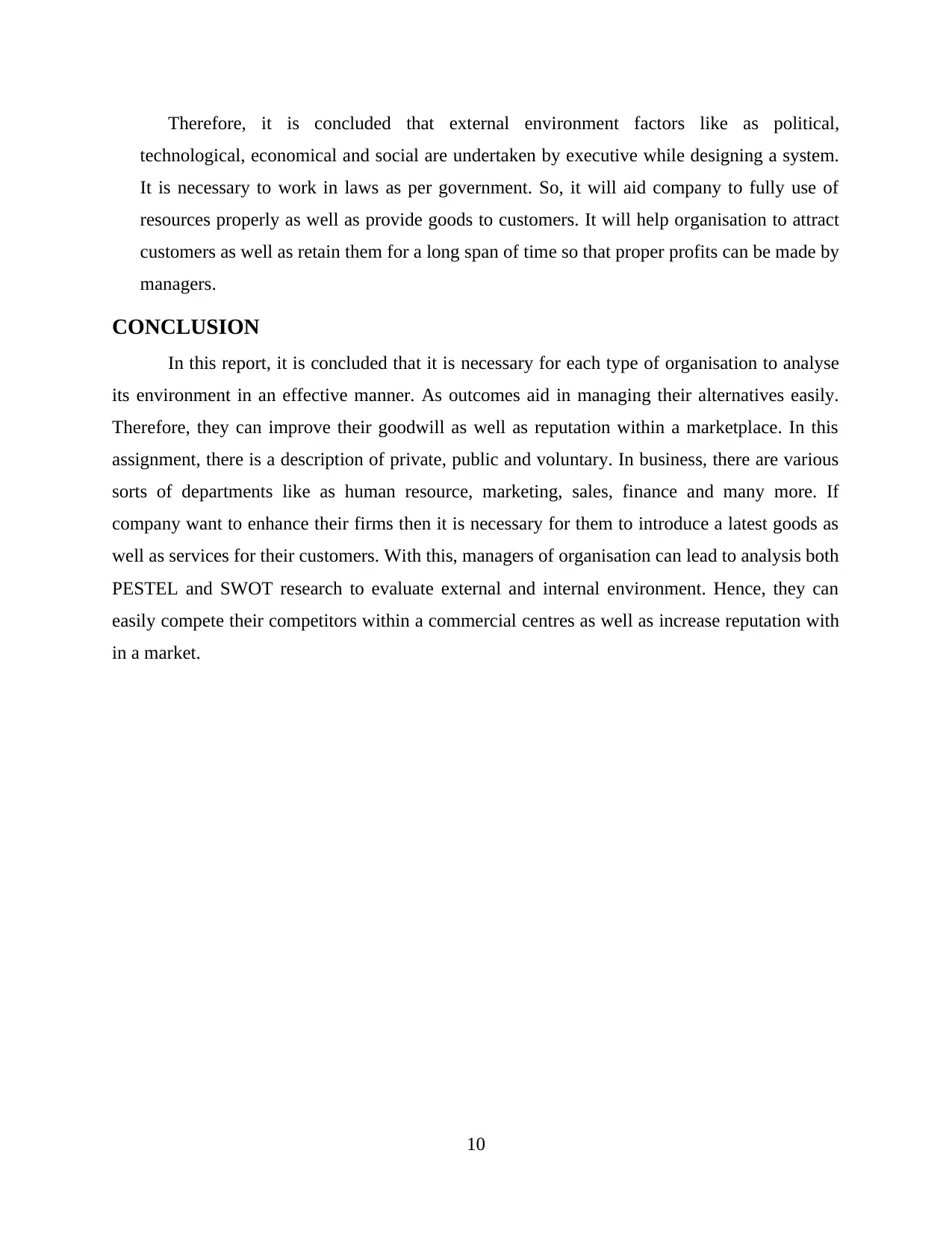
Therefore, it is concluded that external environment factors like as political,
technological, economical and social are undertaken by executive while designing a system.
It is necessary to work in laws as per government. So, it will aid company to fully use of
resources properly as well as provide goods to customers. It will help organisation to attract
customers as well as retain them for a long span of time so that proper profits can be made by
managers.
CONCLUSION
In this report, it is concluded that it is necessary for each type of organisation to analyse
its environment in an effective manner. As outcomes aid in managing their alternatives easily.
Therefore, they can improve their goodwill as well as reputation within a marketplace. In this
assignment, there is a description of private, public and voluntary. In business, there are various
sorts of departments like as human resource, marketing, sales, finance and many more. If
company want to enhance their firms then it is necessary for them to introduce a latest goods as
well as services for their customers. With this, managers of organisation can lead to analysis both
PESTEL and SWOT research to evaluate external and internal environment. Hence, they can
easily compete their competitors within a commercial centres as well as increase reputation with
in a market.
10
technological, economical and social are undertaken by executive while designing a system.
It is necessary to work in laws as per government. So, it will aid company to fully use of
resources properly as well as provide goods to customers. It will help organisation to attract
customers as well as retain them for a long span of time so that proper profits can be made by
managers.
CONCLUSION
In this report, it is concluded that it is necessary for each type of organisation to analyse
its environment in an effective manner. As outcomes aid in managing their alternatives easily.
Therefore, they can improve their goodwill as well as reputation within a marketplace. In this
assignment, there is a description of private, public and voluntary. In business, there are various
sorts of departments like as human resource, marketing, sales, finance and many more. If
company want to enhance their firms then it is necessary for them to introduce a latest goods as
well as services for their customers. With this, managers of organisation can lead to analysis both
PESTEL and SWOT research to evaluate external and internal environment. Hence, they can
easily compete their competitors within a commercial centres as well as increase reputation with
in a market.
10
⊘ This is a preview!⊘
Do you want full access?
Subscribe today to unlock all pages.

Trusted by 1+ million students worldwide
1 out of 14
Related Documents
Your All-in-One AI-Powered Toolkit for Academic Success.
+13062052269
info@desklib.com
Available 24*7 on WhatsApp / Email
![[object Object]](/_next/static/media/star-bottom.7253800d.svg)
Unlock your academic potential
Copyright © 2020–2025 A2Z Services. All Rights Reserved. Developed and managed by ZUCOL.





